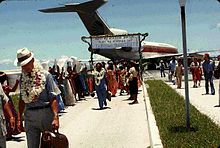This articleneeds additional citations forverification.(May 2009) |
TheUnited Nations trust territorieswere the successors of the remainingLeague of Nations mandates,and came into being when theLeague of Nationsceased to exist in 1946. All the trust territories were administered through theUnited Nations Trusteeship Counciland authorized to a single country. The concept is distinct from aterritory temporarily and directly governed by the United Nations.




The one League of Nations mandate not succeeded by a trust territory wasSouth West Africa,atSouth Africa's insistence. South Africa'sapartheidregime refused to commit to preparing the territory for independence andmajority rule,as required by the trust territory guidelines, among other objections. South-West Africa eventually gained independence in 1990 asNamibia.
All trust territories have either attained self-government orindependence.The last wasPalau,formerly part of theTrust Territory of the Pacific Islands,which became amember state of the United Nationsin December 1994.
Trust territories (and administering powers)
editFormer GermanSchutzgebiete
editAll these territories previously were League of Nations mandates.
| Trust territories | United Nations Trusteeship Power | Prior name | Prior sov. | Comments | Current state |
|---|---|---|---|---|---|
| British Cameroon | United Kingdom | Kamerun | German colonial empire | Following aplebiscite,Northern Cameroonsbecame part ofNigeriain May 1961 andSouthern Cameroonsjoined Cameroon in October 1961. | Nigeria Republic of Cameroon |
| Republic of Cameroon | |||||
| French Cameroon | France | Achieved independence asCameroonin 1960. | |||
| Territory of Nauru | Australia,New Zealand,United Kingdom | German New Guinea | Granted independencefrom Australia (administering authority) in 1968. | Nauru | |
| Territory of New Guinea | Australia | In 1975, it was legally unified with theTerritory of Papuaand granted independence asPapua New Guinea.Thewestern halfof theisland,formerly Dutch and now part ofIndonesia,was never part of either territory. | Papua New Guinea | ||
| Ruanda-Urundi | Belgium | German East Africa | Separately gained independence in 1962 asRepublic of RwandaandKingdom of Burundi. | Republic of Rwanda | |
| Republic of Burundi | |||||
| Tanganyika Territory | United Kingdom | Granted independence in 1961. Federated with the former British protectorateZanzibarin 1964 to formTanzania. | United Republic of Tanzania | ||
| French Togoland | France | Togoland | Became independent asTogoin 1960. | Togo | |
| British Togoland | United Kingdom | This territory was merged in 1956 with the British colony of theGold Coast,which was granted independence asGhanain 1957. | Ghana | ||
| Western Samoa | New Zealand | German Samoa | Granted independence in 1962, known since 1997 simply asSamoa. | Independent State of Samoa |
Former Japanese colonies
edit| Trust territories | United Nations Trusteeship Power | Prior name | Prior sov. | Current state | Comments |
|---|---|---|---|---|---|
| Trust Territory of the Pacific Islands | United States | South Seas Mandate | Empire of Japan | Northern Mariana Islands | BecameUS Commonwealthin 1986. |
| Marshall Islands | Became anassociated stateof the United States after signing aCompact of Free Associationin 1986. | ||||
| Federated States of Micronesia | Became an associated state of United States after signing a Compact of Free Association in 1986. | ||||
| Palau | Became an associated state of United States after signing and ratifying a Compact of Free Association going into effect in 1994. |
Former Italian possessions
edit| Trust territories | United Nations Trusteeship Power | Prior name | Prior sov. | Current state | Comments |
|---|---|---|---|---|---|
| Territory of Somaliland | Italy | Italian East Africa | Italian Empire | Somalia | In 1960, the Trust Territory merged with theState of Somalilandto form theSomali Republic |
Proposed trust territories
edit- Jerusalem:Under theUnited Nations Partition Plan for Palestine,Jerusalem would have become acorpus separatumterritory under United Nations Trusteeship Council administration. BothPalestinian Arabsand theYishuvopposed this solution.
- Korea:In wartime talks,Franklin D. Rooseveltproposed that Korea be placed under an American–Soviettrust administration. The plan was eclipsed after Roosevelt's death on 12 April 1945, although it was expressed in the DecemberMoscow Conference,and caused considerable civil unrest in Korea.[1]
- Vietnam:Roosevelt also proposed thatFrench Indochinabe placed under an international trusteeship as an alternative toFrench colonial ruleand immediate independence.[2]
- Italian Libya:Between 1945 and 1947, the Soviet Union made various proposals thatTripolitaniabe placed under Soviet trusteeship for ten years, or a joint trusteeship with the United Kingdom and the United States, or that Libya as a whole become an Italian trusteeship.[3]
- Mandatory Palestine:The United States government underHarry Trumanproposed a UN trusteeship status for the Mandatory Palestine in 1948.[4][5]
- Ryukyu IslandsandBonin Islands:theTreaty of San Franciscoincluded provisions which provided the United States the right to convert its administration over the Ryukyu and Bonin Islands into a trust territory, but it never did so before sovereignty was voluntarily reverted to Japan.[6]
See also
editReferences
edit- ^Gang Man-gil (1994). "한국사 17: 분단구조의 정착 1" [ "17 Korean history: the settlement of the division structure 1" ], pp. 133–137. 한길사 [Hangilsa],ISBN978-89-356-0086-1
- ^Bradley, Mark Philip (31 December 2010), Anderson, David L. (ed.),"1. Setting the Stage: Vietnamese Revolutionary Nationalism and the First Vietnam War",The Columbia History of the Vietnam War,Columbia University Press, pp. 93–119,doi:10.7312/ande13480-003,ISBN978-0-231-13480-4,archivedfrom the original on 9 November 2021,retrieved9 November2021
- ^St John, Ronald Bruce (April 1982). "The Soviet Penetration of Libya".The World Today.38(4): 131–138.JSTOR40395373.
- ^"The United States and the Recognition of Israel: A Chronology".Compiled by Raymond H. Geselbracht from Harry S. Truman and the Founding of Israel (Westport, Connecticut, 1997) by Michael T. Benson.Harry S. Truman Library and Museum. Archived fromthe originalon 31 October 2012.Retrieved3 August2014.
- ^Pugh, Jeffrey D. (1 November 2012)."Whose Brother's Keeper? International Trusteeship and the Search for Peace in the Palestinian Territories".International Studies Perspectives.13(4): 321–343.doi:10.1111/j.1528-3585.2012.00483.x.ISSN1528-3577.Archivedfrom the original on 12 October 2017.Retrieved15 June2017.
- ^"ARGENTINA, AUSTRALIA, BELGIUM, BOLIVIA, BRAZIL, etc. - Treaty of Peace with Japan (with two declarations)"(PDF).8 September 1951. Archived fromthe original(PDF)on 29 September 2017.
Bibliography
edit- The United Nations and Decolonization:Trust Territories that Have Achieved Self-Determination
- WorldStatesmen – Index of Possessions and Colonies
External links
edit- Media related toUnited Nations Trust Territoriesat Wikimedia Commons